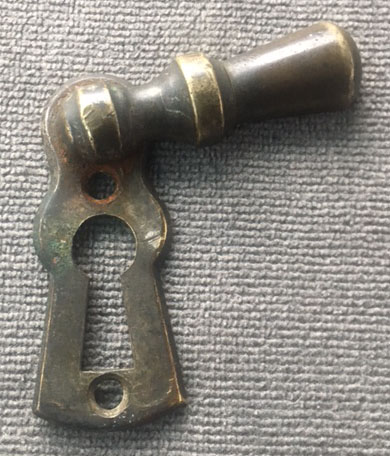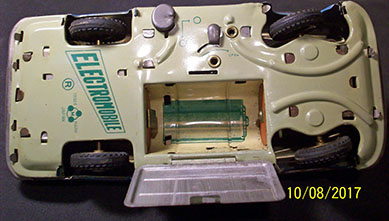 |
|
|||
 |
 |
|||
Copyright © Harry Rinker, LLC 2018 Questions
and Answers
QUESTION: A buddy recently gave me a lock escutcheon to which a swing drop shaped like an old time Coca-Cola bottle was attached at the top. You probably have seen similar examples multiple times. I never had. I call it the original security system. When a couple went into a room to kiss or whatever, this device prevented their kids or anyone from peeking through the keyhole. Does this specialized escutcheon have any value? – KT, Madisonville, KY, Email Question 
ANSWER: I confess you had me going for a minute or two. I have no memory of seeing such a device on the inside of a door, albeit I do not dispute its use as described if located there. The device was used on the outside of the door, most often an exterior door. Its purpose was to prevent wind from blowing through the keyhole. A secondary purpose was to avoid snow or blowing debris from blocking the keyhole. Once I realized its purpose, I remembered encountering a number of such devices. “Swing cover escutcheon” is the technical term for these devices. In my research, I found many 19th century examples. The concept dates much earlier. Swing cover escutcheons still are manufactured today. The House of Antique Hardware (www.houseofantiquehardware.com) offers a “solid brass Colonial keyhole cover with swinging draft cover” identical to the one you own for $6.99 plus shipping. For those looking to create an affordable collection, consider swing cover escutcheons. Common period examples, such as the one owned by KT, sell for under $10.00. Elaborate Victorian era covers with ornate pressed Baroque-design motifs sell between $40.00 and $60.00. Check American and British internet sale venues. Be patient and take time to learn the secondary marketplace. Do not buy the first example you see. As of December 16, 2017, there is an eBay “Buy It Now” listing for a “Key Hole Door Lock Plate Swing Cover Escutcheon Victorian Eastlake Bronze” for $40.00 with 11 individuals watching. This means 11 individuals feel the asking price is too high. Kudos to them for their unwillingness to pay more than something is worth. QUESTION: In the late 1930s, my father designed and built stage sets and backdrops for vaudeville shows in New Jersey, New York, and Pennsylvania. I recently pulled out a backdrop that had been stored in a big wooden trunk for decades. It is in very good condition and measures 30 feet (360 inches) by 18 feet (276 inches). The scene is a big city background – late 19th or early 20th century buildings. The buildings are semi-realistic. When I approached my local auctioneer asking him to sell it, he informed me that he had never seen (pun definitely intended) one before. Most of the examples I found are in museums. I took the full view picture hanging out the second-floor window of my home. Any help would be appreciated. – NO, Reading, PA, Email Question 
ANSWER: Size does impact the value of an antique or collectible. An object can be too big. Eighteen feet by 30 feet is definitely too big. Unless a person owns a building with an auditorium, a barn, or has wall space measuring greater than 30 feet by 18 feet that needs covering, the secondary buyer market is minimal. The first thing to consider is whether the backdrop has historical value. I assume that if you can identify the theater and show in which the backdrop was used, the information would have been included in your email. How famous was your father as a backdrop painter? Based on the information you provided, he may have done backdrops for New York City or Philadelphia theaters. You need to put together a documented biography of your father’s role as a stage backdrop painter. Consider donating the backdrop to a local regional or urban theater. Chances of finding a theater willing to accept it will be a challenge. Contact The Theater Museum (30 Worth Street, Manhattan, New York, NY 10013) to determine their interest. If the museum does not want it, ask if they can provide you with a recommendation as to who might want it. The Smithsonian’s National Museum of American History is a long-shot but worth a “desperation” try. If you do find someone to accept it, a taxation deduction up to $4,999.00 is permitted with a letter of acceptance indicating the recipient is a 501(c)3 organization. Let your conscience be your guide as Jimmy Cricket said in Pinocchio. Selling it locally most likely will lead to disaster. If it brings more than a few hundred dollars, I will be surprised. Another long-shot is to contact Heritage Auctions (www.ha.com) in Dallas, Texas. They have a strong buyer clientele and love selling the unusual. If you are successful in finding a new home for the backdrop, please email me with the results of the solution you used. QUESTION: I have a tin, battery operated Electromobile police car. I received it as a child and took very good care of it. My father insisted that I remove the battery from the battery case when I finished playing with it. Hence, the battery case is in excellent condition. The car runs and the light works when I insert a battery. The box is missing. I would appreciate any information you can provide. – TK, Timberlake, OH, Email Question 
ANSWER: Your Electromobile police car dates from the 1950s. The period box for your car, which you do not have, is marked with the letter “M.” The website tinplatetoys.blogspot.com (http://tinplatetoys.blogspot.com/p/index-of-japanese-tinplate-toy.html) contains a list of Japanese tin toy manufacturers who made tin toys. Mizuno / Nihon Alps Mizuno Seisakusho, located in Ueda City, Japan used an “M” in a circle. Mura Toy Co. / Miura Shoji Co. Ltd, used an “M” in three concentric circles. In researching the Electromobile, I found several listings attributing the car to Mizuno. The four-door sedan, which came in a variety of colors, was the most popular of the Electromobile variations. Other variations included a fire chief car, police car, and taxi. The cars had a Buick-type body. A version with an attached battery-operated control unit was marketed under the Mizuno Nihon Alps Seisakusho logo. Most Electromobile examples appear on the market without the box. A check of recent sales on WorthPoint.com shows sell through prices for the sedan ranging from $100.00 to $125.00. On May 31, 2017, a police care sold on eBay for $195.00. Its condition matched the example that you own. An example in fair (heavily played with) condition closed at $66.00 on eBay on September 7, 2017. As always, I recommend thinking conservatively. A fair secondary market value for your police car is between $150.00 and $175.00. 
QUESTION: I own a German key wound, tin “Sweetheart Dancing Doll” in its period box. The young man is wearing an Alpine hat, red and white checkered shirt, and lederhosen. The box lid pictures a couple dancing. The box notes: “Tanzpuppe.” When was my dancing doll made and what is its value? – M, Altoona, PA ANSWER: Your Sweetheart Dancing doll was made in West Germany in the late 1940s or early 1950s. “Tanzpuppe” means dancing doll. There was a male and female dancer, each of which came in a variety of different costumes. The male dancer in lederhosen with a red or blue checkered shirt is the most common male costume variation. I also found examples in a sailor’s outfit and a formal folk jacket and brown pants. The female dancers are dressed in regional tracht (folk costumes), such as Black Forest Sunday dress and a Heidi-like mountain outfit. I found at least eight female variations in my brief internet research. Several listings identify Seppi as the manufacturer. Although probably correct, I did not find enough supporting evidence to fully convince me. A surprising number of these dolls appear to have survived in their period boxes. The average asking price on eBay is around $15.00. Few sell through at this asking price. Harry L. Rinker welcomes questions from readers about
collectibles, those mass-produced items from the twentieth and twenty-first centuries.
Selected letters will be answered in this column.
Harry cannot provide personal answers.
Photos and other material submitted cannot be
returned.
Send your questions to: Rinker on Collectibles, 5955 Mill
Point Court SE, Kentwood, MI 49512.
You also can e-mail your questions to
harrylrinker@aol.com.
Only e-mails containing a full name and mailing address
will be considered.
You can listen
and participate in
WHATCHA GOT?, Harry’s
antiques and collectibles radio call-in show, on Sunday mornings between 8:00 AM
and 10:00 AM Eastern Time.
If you
cannot find it on a station in your area,
WHATCHA GOT?
streams live on the Internet at www.gcnlive.com.
|
||||